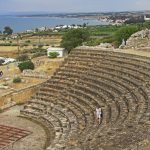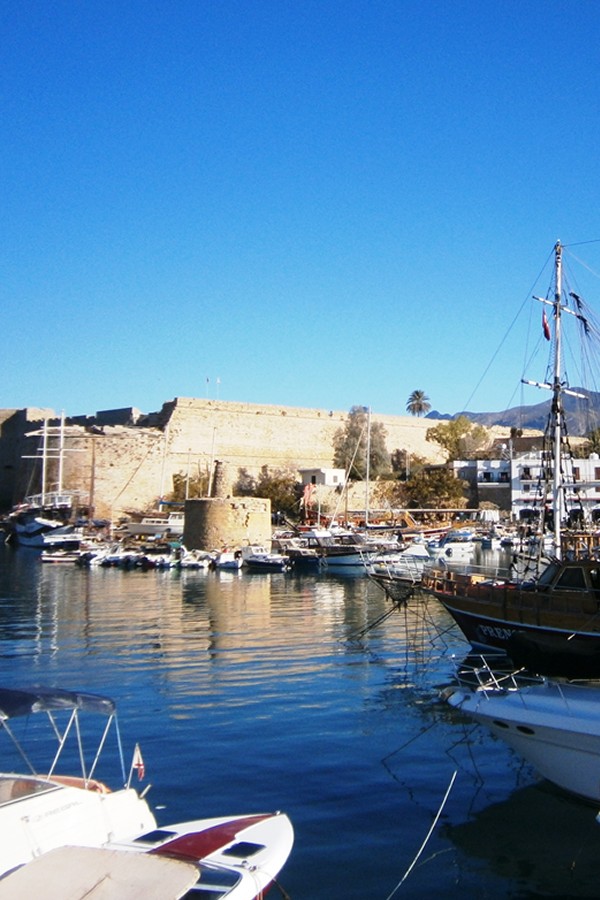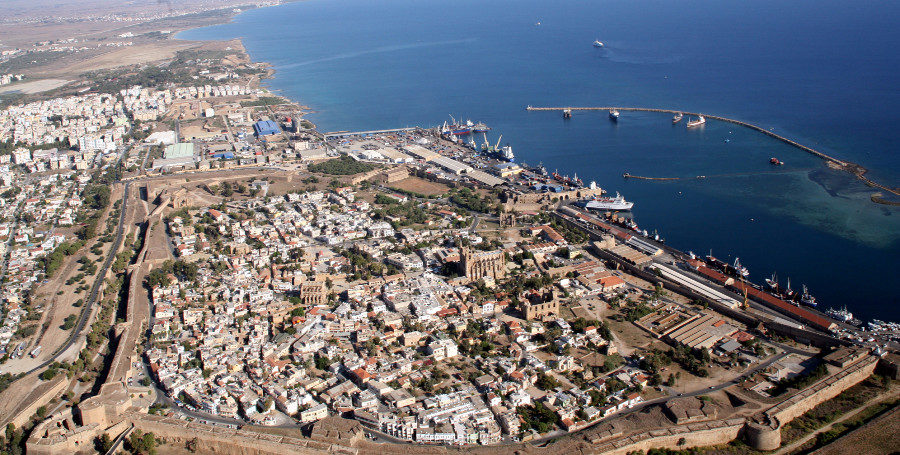
You can also listen this article.
Famagusta, also known as Gazimağusa in Turkish, is a city located on the eastern coast of North Cyprus. It is one of the major urban centers in the region and holds great historical and cultural significance. Famagusta is divided into two main areas: the old city, which is enclosed within medieval walls, and the modern city outside the walls.
History
The history of Famagusta in North Cyprus is deeply intertwined with the broader historical developments of the island of Cyprus. Here is a timeline highlighting the key events in the history of Famagusta:
3rd century BC: Famagusta is founded by the Greeks and serves as a small trading post.
1192: Famagusta comes under the control of the Lusignan dynasty after the Crusades. Under Lusignan rule, the city flourishes and becomes a major center of trade and culture.
1489: Famagusta falls under the rule of the Venetians, who further develop the city’s fortifications, including the construction of the impressive city walls.
1571: The Ottoman Empire, under the leadership of Sultan Selim II, conquers Famagusta after a long siege. The Venetian defenders, led by Marcantonio Bragadin, suffer a brutal defeat, and the city comes under Ottoman rule for the next three centuries.
1878: With the signing of the Cyprus Convention, the Ottoman Empire hands over the administration of Cyprus to the British Empire. Famagusta continues to serve as a key port under British colonial rule.
1955-1959: The EOKA (National Organization of Cypriot Fighters) insurgency against British rule spreads across Cyprus, including Famagusta.
1960: Cyprus gains independence from British rule. Famagusta becomes part of the Republic of Cyprus and serves as a bustling commercial center.
1974: Following a coup aiming to unify Cyprus with Greece, Turkey intervenes militarily, leading to the division of Cyprus. Famagusta ends up in the northern part, which becomes the Turkish Republic of Northern Cyprus (TRNC).
1974-1983: Famagusta remains under the control of the TRNC, but the city becomes a ghost town due to the displacement of Greek Cypriot inhabitants who fled south.
1983-present: Famagusta remains under the administration of the TRNC, and efforts to resolve the division of the city and Cyprus as a whole continue.
Despite the political division, Famagusta retains its historical and cultural significance. The old city walls, Othello Castle, Lala Mustafa Pasha Mosque, and St. Nicholas Cathedral stand as reminders of the city’s diverse heritage. The city’s position as a major port and its economic potential continue to shape its modern development within the context of the broader geopolitical situation on the island of Cyprus.
Landmarks and Attractions
Famagusta in North Cyprus is home to several remarkable landmarks and attractions that showcase its rich history and cultural heritage. Here are some of the notable sites you can explore:

- Old City Walls: The Venetian-built city walls are a prominent feature of Famagusta. These well-preserved fortifications encircle the old city and offer panoramic views of the surrounding area. Walking along the walls provides a glimpse into the city’s past and offers a unique perspective of Famagusta.
- Othello Castle: Located within the city walls, Othello Castle, also known as the Citadel of Famagusta, is believed to have inspired Shakespeare’s play “Othello.” This medieval fortress dates back to the 14th century and has served various purposes throughout history, including a palace, a prison, and a venue for cultural events.
- Lala Mustafa Pasha Mosque: Formerly known as St. Nicholas Cathedral, this impressive Gothic-style building was constructed during the Lusignan period. After the Ottoman conquest, it was converted into a mosque. The mosque’s architecture blends Gothic and Islamic influences, making it a fascinating site to visit.
- Namık Kemal Dungeon: Situated beneath the city walls, the Namık Kemal Dungeon is an underground prison that was used during the British colonial period. It now serves as a museum, showcasing the harsh conditions and historical context of the era.
- St. Nicholas Cathedral: Also known as the Church of Ayios Nikolaos, this cathedral is an exquisite example of Gothic architecture. Built during the Lusignan period, it now operates as a museum exhibiting medieval artifacts, including religious relics and intricate stone carvings.
- Salamis Ancient City: Located just outside of Famagusta, the ancient city of Salamis is an archaeological site of immense historical significance. It was once a major port and an important center of the Roman and Byzantine empires. Visitors can explore the ruins, including an amphitheater, Roman baths, and the Gymnasium of Salamis.
- Palm Beach: Famagusta is known for its stunning beaches, and Palm Beach is one of the most popular. Located north of the city, it boasts golden sands, crystal-clear waters, and a serene atmosphere, offering visitors a tranquil spot for relaxation and swimming.
These landmarks and attractions, among others, make Famagusta a captivating destination for history enthusiasts, culture lovers, and beachgoers. The city’s historical significance and natural beauty contribute to its unique charm and draw tourists from around the world.
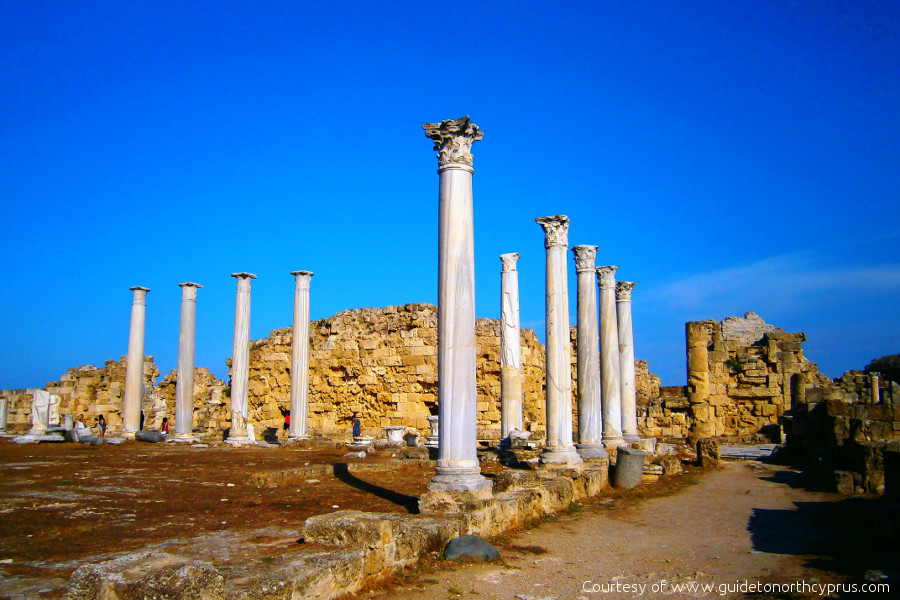
Education and Culture
Famagusta in North Cyprus is home to a thriving education sector and a vibrant cultural scene. Here’s an overview of the education and cultural aspects of Famagusta:
Education:
- Eastern Mediterranean University (EMU): Located in Famagusta, EMU is a prestigious institution offering a wide range of academic programs. It attracts a diverse student body from various countries and is known for its strong faculties in fields such as engineering, social sciences, business, and arts.
- Gazimağusa Türk Maarif College: This renowned private school provides quality education from pre-school to high school levels. It follows the Turkish curriculum and offers a well-rounded education with extracurricular activities and academic excellence.
- Mağusa Türk Güzel Sanatlar Lisesi (Famagusta Turkish Fine Arts High School): This specialized high school focuses on nurturing artistic talent and offers programs in visual arts, music, and theater.
Cultural Scene:
- International Famagusta Arts and Culture Festival: This annual festival celebrates arts and culture in Famagusta. It features a diverse range of performances, including music concerts, dance shows, theater productions, and art exhibitions. The festival aims to promote local and international artists and provides a platform for cultural exchange.
- Famagusta Municipality Cultural Center: The cultural center hosts various events, including music concerts, theatrical performances, film screenings, and art exhibitions. It serves as a hub for promoting local artists and cultural activities within the city.
- Traditional Festivals and Celebrations: Famagusta embraces its cultural heritage through traditional festivals and celebrations. Events like the Karpaz Olive Festival and International Folk Dance Festival bring together local communities and visitors to showcase traditional music, dance, crafts, and cuisine.
- Famagusta Walled City Association: This organization focuses on the preservation and promotion of the walled city of Famagusta. They organize cultural events, guided tours, and educational programs to raise awareness about the historical significance of the city and its landmarks.
- Famagusta Museum of Nature and Archaeology: Located within the walled city, this museum exhibits artifacts and displays related to the natural history and archaeology of the region. It provides insights into the rich cultural heritage of Famagusta and its surroundings.
Famagusta’s education institutions and cultural initiatives contribute to a vibrant intellectual and artistic environment. The city embraces its historical roots while fostering contemporary expressions of art and culture, making it an engaging and dynamic destination for both residents and visitors.
Beaches and Tourism
Famagusta in North Cyprus offers a variety of beautiful beaches and a growing tourism sector. Here are some of the noteworthy beaches and tourist attractions in Famagusta:
- Palm Beach: Located to the north of Famagusta, Palm Beach is a popular destination known for its soft golden sands and clear turquoise waters. It offers a tranquil atmosphere and is ideal for sunbathing, swimming, and water sports.
- Glapsides Beach: Situated near the ancient city of Salamis, Glapsides Beach is known for its long stretch of sandy coastline. The beach is well-equipped with facilities, including restaurants, cafes, and beach bars, making it a perfect spot for a day of relaxation.
- Silver Beach: Located on the Karpaz Peninsula, Silver Beach is renowned for its pristine sands and crystal-clear waters. It offers a serene environment and is ideal for swimming, snorkeling, and picnicking.
- Bogaz Beach: Situated in the fishing village of Bogaz, this beach provides a charming setting with its small harbor and traditional fishing boats. It offers a mix of sand and pebbles, and visitors can enjoy swimming, sunbathing, and exploring the local eateries.
- Famagusta Walled City: The historic walled city of Famagusta itself is a major attraction for tourists. The well-preserved medieval city walls, along with landmarks like Othello Castle, St. Nicholas Cathedral, and Lala Mustafa Pasha Mosque, provide visitors with a glimpse into the city’s rich history.
- Salamis Ancient City: Located near Famagusta, the ancient city of Salamis is a must-visit for history enthusiasts. It boasts impressive archaeological ruins, including a Roman theater, Roman baths, and intricate mosaics. Exploring the site offers insights into the grandeur of the ancient city.
- Famagusta City Center: The modern part of Famagusta offers a lively city center with a range of shops, restaurants, cafes, and local markets. Visitors can stroll through the streets, enjoy shopping for traditional handicrafts, and experience the local cuisine.
- Karpaz Peninsula: Famagusta serves as a gateway to the scenic Karpaz Peninsula. This pristine area is renowned for its untouched natural beauty, including golden beaches, wildlife, and the famous Apostolos Andreas Monastery.
Famagusta’s beaches and tourist attractions cater to a wide range of interests, whether it’s relaxation, historical exploration, or experiencing the local culture. The city’s strategic location, rich history, and natural attractions make it an appealing destination for tourists in North Cyprus.
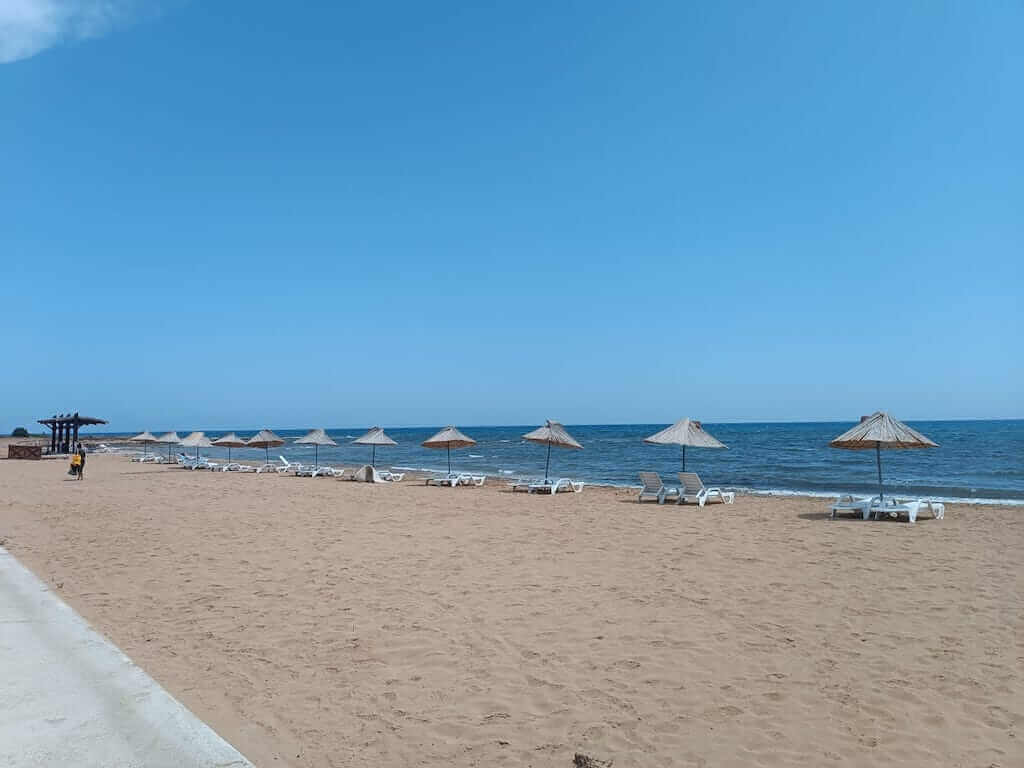
Economic Significance
Famagusta in North Cyprus holds economic significance in various sectors. Here are some key aspects of its economic contribution:
- Tourism: Famagusta is a popular tourist destination, attracting visitors with its historical sites, beautiful beaches, and cultural attractions. The tourism industry plays a significant role in the local economy, contributing to job creation, revenue generation, and the development of related businesses such as hotels, restaurants, and tour operators.
- Education: The presence of Eastern Mediterranean University (EMU) in Famagusta has a positive impact on the local economy. The university attracts international students, contributing to the growth of the education sector. It also stimulates the housing market, creates employment opportunities in academic and support staff roles, and fosters research and innovation.
- Trade and Commerce: Famagusta serves as a commercial hub in North Cyprus. The city’s port facilitates trade and transportation, supporting import-export activities and serving as a gateway for goods. The commercial sector in Famagusta includes various businesses such as retail, wholesale, logistics, and services, which contribute to the local economy.
- Agriculture and Fisheries: The surrounding region of Famagusta is known for its fertile agricultural land and fishing industry. Agricultural activities include the cultivation of citrus fruits, vegetables, olives, and grains. The fishing industry involves both commercial and artisanal fishing, providing a source of income for local communities and contributing to the regional economy.
- Construction and Real Estate: Famagusta has witnessed significant development in the construction and real estate sectors. The growth of tourism and the increasing demand for residential properties have led to the construction of hotels, resorts, residential complexes, and commercial buildings. This sector creates employment opportunities and stimulates economic activity.
- Services Sector: The services sector, including financial services, healthcare, professional services, and retail, contributes to the local economy. Famagusta has a range of banks, healthcare facilities, professional offices, and commercial establishments that cater to the needs of residents and businesses.
It is important to note that the economic situation in Famagusta is influenced by the unique political circumstances of North Cyprus and the ongoing efforts to resolve the division of the island. However, the city’s strategic location, diverse economic sectors, and attractions continue to contribute to its economic significance in the region.



